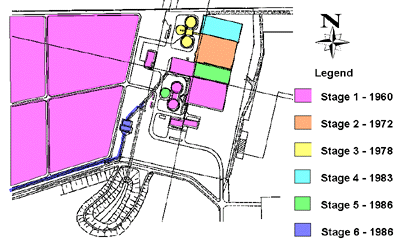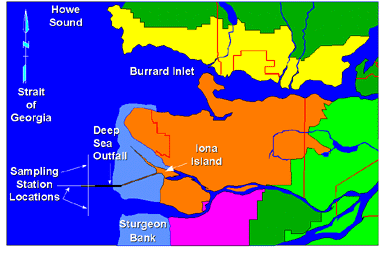

| Characteristics | Value |
| BOD removal (avg. daily) | 27,520 kg |
| BOD removal efficiency | 39 % |
| TSS removal (avg. daily) | 31,470 kg |
| TSS removal efficiency | 49 % |

| Sampling station number | Location relative to the diffusers | Total copper concentrations in sediments (mg / kg DW) | |||
| 1974 | 1986 | 1990 | 1994 | ||
| 42 | 4 km N | 46 | - | 44 | 43 |
| 30 | 2 km N | 44 | 44 | 43 | 49 |
| 31 | 1 km N | 44 | 41 | 42 | 47 |
| 33 | Diffusers | 43 | 42 | 41 | 33 |
| 35 | 1 km S | 44 | 40 | 42 | 44 |
| 44 | 4 km S | 40 | - | - | 44 |
| Sampling station number | Location relative to the diffusers | Total lead concentrations in sediments (mg / kg DW) | |||
| 1974 | 1986 | 1990 | 1994 | ||
| 42 | 4 km N | 18 | - | 17 | 12 |
| 30 | 2 km N | 16 | 18 | 16 | 13 |
| 31 | 1 km N | 16 | 18 | 15 | 11 |
| 33 | Diffusers | 15 | 18 | 15 | 9 |
| 35 | 1 km S | 14 | 17 | 14 | 11 |
| 44 | 4 km S | 16 | - | - | 12 |
| Characteristics | Value |
| 25 % dry weather flow (DWF) | 404.7 ML / d |
| Peak wet weather flow (WWF) | 1,322.8 ML / d |
| Peak WWF / DWF ratio | 3.27 |
| Annual treatment flow | 196,293 ML |
| Annual dry weather flow | 147,460 ML |


